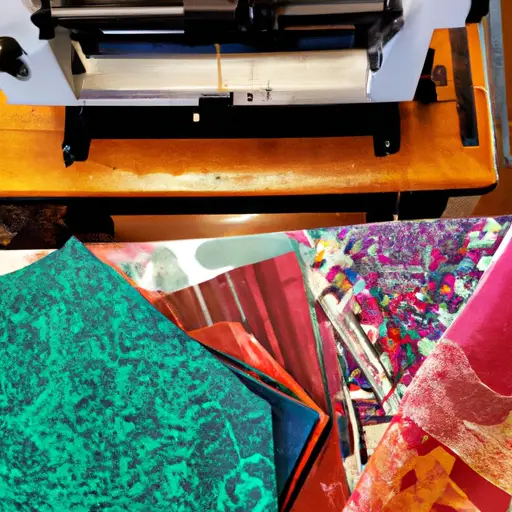Screen printing and block printing are two popular techniques for creating unique and personalized designs on textiles. Both methods allow individuals to unleash their creativity and transform ordinary fabrics into eye-catching works of art.
Whether you are a seasoned artist or a beginner looking to explore the world of textile printing, this article will guide you through the entire process, from start to finish, of DIY screen printing and block printing on textiles.
To begin, it is essential to understand the basics of screen printing and block printing. Screen printing involves creating a stencil, or screen, and using it to transfer ink onto a fabric. This technique allows for the creation of intricate and multi-colored designs.
On the other hand, block printing involves carving a design onto a block of material, such as wood or linoleum, and using it to stamp the design onto the fabric. Block printing is a versatile technique that can produce both bold and delicate designs.
In order to embark on your DIY printing journey, you will need to gather the necessary supplies. This includes screens, squeegees, inks, fabric, carving tools, and blocks, among other materials.
Preparing your design for printing is also a crucial step. This involves creating or selecting a design, transferring it onto the appropriate medium (such as a screen or block), and ensuring it is properly aligned for printing.
With the right tools and preparation, you can dive into the step-by-step guide that will take you through the screen printing and block printing techniques, allowing you to unleash your creativity and bring your innovative ideas to life on textiles.
Understanding the Basics of Screen Printing and Block Printing
An exploration of the fundamental principles behind screen printing and block printing on textiles provides a comprehensive understanding of these techniques.
Screen printing involves transferring ink onto a substrate through a mesh screen that has a stencil of the desired design. The process begins with preparing the screen by coating it with a light-sensitive emulsion and letting it dry. Once dry, a negative image of the design is placed on the screen, and it is exposed to light. The areas that were exposed to light harden, while the areas covered by the negative design remain soft. The screen is then washed, and the soft areas are removed, creating a stencil.
When printing, ink is placed on the screen and spread over the stencil using a squeegee, forcing the ink through the mesh onto the fabric. This technique allows for precise and consistent prints, making it popular in the textile industry.
Block printing, on the other hand, involves carving a design into a block of material, usually wood or linoleum. The carved surface is then coated with ink, and the block is pressed onto the fabric to transfer the design. This technique dates back thousands of years and has been used in various cultures around the world.
Block printing allows for intricate designs and details, as the carvings can be quite intricate. It also provides a unique handmade quality to the prints, as each block can be slightly different, adding character to the final product.
Both screen printing and block printing offer endless possibilities for creativity and innovation, allowing individuals to bring their unique designs to life on textiles.
Gathering the Necessary Supplies
To gather the necessary supplies for this process, one must first obtain a variety of tools and materials.
For screen printing, key supplies include:
- A screen frame
- Mesh fabric
- A squeegee
- Screen printing ink
- A design or stencil
The screen frame acts as the base for the printing process and should be sturdy and rigid. Mesh fabric is stretched over the frame and acts as the medium through which the ink is transferred onto the textile. A squeegee is used to evenly distribute the ink across the screen, applying pressure to ensure proper ink transfer. Additionally, high-quality screen printing ink is essential for achieving vibrant and durable prints. Lastly, having a design or stencil is crucial as it determines the pattern or image that will be printed.
For block printing, the necessary supplies include:
- A carving tool
- Linoleum or wood block
- Ink
- A brayer
- Paper or fabric
The carving tool is used to carve the design into the linoleum or wood block, creating a relief surface. This relief surface is then inked using a brayer, which is a roller with a handle. The inked block is then pressed onto the paper or fabric, transferring the design. It is important to choose the right type of ink for block printing, as some inks may not adhere well to certain surfaces. Lastly, selecting the appropriate paper or fabric is crucial for achieving the desired result, as different textures and absorbency levels can affect the final print quality.
By gathering these essential tools and materials, one can embark on the exciting journey of screen printing and block printing on textiles, unleashing their creativity and bringing innovative designs to life.
Preparing Your Design for Printing
Preparing your design for printing involves carefully considering the size, complexity, and placement of the design to ensure optimal results on the chosen medium.
The size of the design should be appropriate for the size of the textile or garment you are printing on. If the design is too large, it may not fit properly on the surface, causing distortion or loss of important details. On the other hand, if the design is too small, it may not be easily visible or may appear insignificant. Therefore, it is crucial to carefully measure and scale the design to fit the desired area.
The complexity of the design also plays a significant role in the printing process. Intricate designs with fine lines or small details may require more precision and skill to reproduce accurately. It is important to consider the capabilities of the printing method and the skill level of the printer when choosing or creating a design.
Additionally, the placement of the design on the textile should be carefully considered. The design should be strategically placed to enhance the overall aesthetic and functionality of the product. For example, if you are printing on a t-shirt, you may want to position the design in the center or on the chest area for maximum visibility.
By taking into account these factors, you can ensure that your design is well-suited for printing and will produce optimal results on the chosen medium.
Step-by-Step Guide to Screen Printing and Block Printing Techniques
Executing intricate designs with fine lines or small details requires a step-by-step approach that incorporates the screen printing and block printing techniques for optimal results on different mediums.
Screen printing is a versatile technique that allows for the reproduction of intricate designs on various textiles. The process involves creating a stencil, known as a screen, and transferring ink onto the fabric through the open areas of the stencil.
To start, the design is transferred onto a transparent film, which is then placed on top of the screen. Using a light source, the design is exposed onto the screen, creating a stencil. The screen is then placed on top of the fabric, and ink is spread across the screen using a squeegee. The ink passes through the open areas of the stencil, creating the desired design on the fabric.
For block printing, a similar step-by-step approach is followed. However, instead of using a screen, a block with the design carved into it is used. The block is inked and pressed onto the fabric, transferring the design onto the surface.
Both techniques require precision and attention to detail to ensure that the design is accurately reproduced.
Screen printing and block printing techniques provide a step-by-step approach that allows for the execution of intricate designs with fine lines or small details on textiles. These techniques require careful planning and precision to achieve optimal results.
By following these step-by-step processes, artists and designers can create innovative and unique designs that capture the attention of their audience. Whether it’s screen printing or block printing, these techniques offer endless possibilities for creativity and expression on various mediums.
Conclusion
In conclusion, screen printing and block printing are two popular techniques for creating unique designs on textiles. Both methods require gathering specific supplies, such as screens, squeegees, and fabric ink, as well as preparing the design for printing.
Screen printing involves transferring the design onto a screen and then pressing ink through it onto the fabric, while block printing uses carved blocks to apply ink directly to the fabric.
By following a step-by-step guide, individuals can successfully execute these techniques and create their own custom printed textiles. It is important to note that practice and experimentation are key to mastering these techniques, as the results may vary depending on the materials and processes used.
With a bit of patience and creativity, anyone can enjoy the art of screen printing and block printing, transforming plain fabrics into vibrant, personalized pieces.
 printablelabelstemplate
printablelabelstemplate
